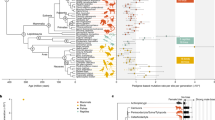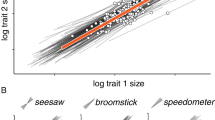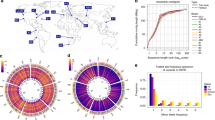Abstract
GENIC heterozygosity at enzyme loci has been examined for correlation with parameters as diverse as substrate specificity1, physiological function2 and quaternary structure3. However, none of these has provided an adequate explanation for allozymic variation in general. One report4 suggested a positive relationship for Drosophila enzymes between heterozygosity and subunit molecular weight (MW), which can be equated to the size of the structural gene element. Various models, both neutral and selective, would predict a correlation between gene size and variability5–7. Recently, a similar correlation has been found within three classes of vertebrates8,31, and between the number of rare alleles and subunit size in human populations9,10. We report here that we have tested the relationship between heterozygosity and subunit size in Drosophila species with a new selection of enzymes. Our results indicate that the correlation is indeed general. The relationship is quasi-linear and does not differ significantly from several models. The results support the hypothesis that there are constraints on the number of sites available to charge substitution within an enzyme molecule.
This is a preview of subscription content, access via your institution
Access options
Subscribe to this journal
Receive 51 print issues and online access
$199.00 per year
only $3.90 per issue
Buy this article
- Purchase on Springer Link
- Instant access to full article PDF
Prices may be subject to local taxes which are calculated during checkout
Similar content being viewed by others
References
Gillespie, J. H. & Kojima, K. Proc. natn. Acad. Sci. U.S.A. 61, 582–585 (1968).
Johnson, G. B. Science 184, 28–37 (1974).
Ward, R. D. Biochem. Genet. 15, 123–135 (1977).
Koehn, R. K. & Eanes, W. F. Theor. Population Biol. 11, 330–341 (1977).
Kimura, M. & Crow, J. F. Genetics 49, 725–738 (1964).
Gillespie, J. H. Evolution 31, 85–90 (1977).
Watterson, G. A. Genetics 85, 789–814 (1977).
Nei, M., Fuerst, P. A. & Chakraborty, R. Proc. natn. Acad. Sci. U.S.A. 75, 3359–3362 (1978).
Eanes, W. F. & Koehn, R. K. Biochem. Genet. 16, 971–985 (1978).
Harris, H., Hopkinson, D. A. & Edwards, Y. H. Proc. natn. Acad. Sci. U.S.A. 74, 698–701 (1977).
Martin, R. G. & Ames, B. N. J. biol. Chem. 236, 1372–1379 (1961).
Laurent, T. C. & Killander, J. J. Chromat. 14, 317–330 (1964).
Andrews, P. Biochem. J. 96, 596–606 (1965).
Lee, C. Y., Langley, C. H. & Burkhart, J. Analyt. Biochem. 86, 697–706 (1978).
Langley, C. H., Ito, K. & Voelker, R. A. Genetics 86, 447–454 (1977).
Zouros, E. Evolution 27, 601–624 (1974).
Saura, A. Hereditas 76, 161–172 (1974).
Langley, C. H., Tobari, Y. N. & Kojima, K. Genetics 78, 921–936 (1974).
Saura, A., Lakovaara, S., Lokki, J. & Lankinen, P. Hereditas 75, 33–46 (1973).
Lakovaara, S. & Saura, A. Genetics 69, 377–384 (1971).
Kojima, K., Smouse, P., Yang, S., Nair, P. S. & Brncic, D. Genetics 72, 721–731 (1972).
Kojima, K., Gillespie, J. H. & Tobari, Y. N. Biochem. Genet. 4, 627–637 (1970).
Band, H. T. Genetics 80, 761–771 (1975).
Ayala, F. J., Tracey, M. L., Barr, L. G., McDonald, J. F. & Perez-Salas, S. Genetics 77, 343–384 (1974).
Johnson, F. M. Genetics 68, 77–95 (1971).
Ohta, T. & Kimura, M. Genet. Res. 22, 201–204 (1973).
Fitch, W. M. & Markowitz, E. Biochem. Genet. 4, 579–593 (1970).
Fitch, W. M. Haemat. Bluttransfusion 10, 199–215 (1972).
Fitch, W. M. J. molec. Evolut. 2, 123–136 (1973).
Wehrhahn, C. F. & Gulizia, C. Genetics (in the press).
Ward, R. D. Biochem. Genet. 16, 799–810 (1978).
Author information
Authors and Affiliations
Rights and permissions
About this article
Cite this article
LEIGH BROWN, A., LANGLEY, C. Correlation between heterozygosity and subunit molecular weight. Nature 277, 649–651 (1979). https://doi.org/10.1038/277649a0
Received:
Accepted:
Published:
Issue Date:
DOI: https://doi.org/10.1038/277649a0
This article is cited by
-
The yellow stingray (Urobatis jamaicensis) can discriminate the geomagnetic cues necessary for a bicoordinate magnetic map
Marine Biology (2020)
-
Lerner's concept of developmental homeostasis and the problem of heterozygosity level in natural populations
Heredity (1985)
-
Genetic variation and environmental heterogeneity in some closely related goby species
Genetica (1984)
Comments
By submitting a comment you agree to abide by our Terms and Community Guidelines. If you find something abusive or that does not comply with our terms or guidelines please flag it as inappropriate.



